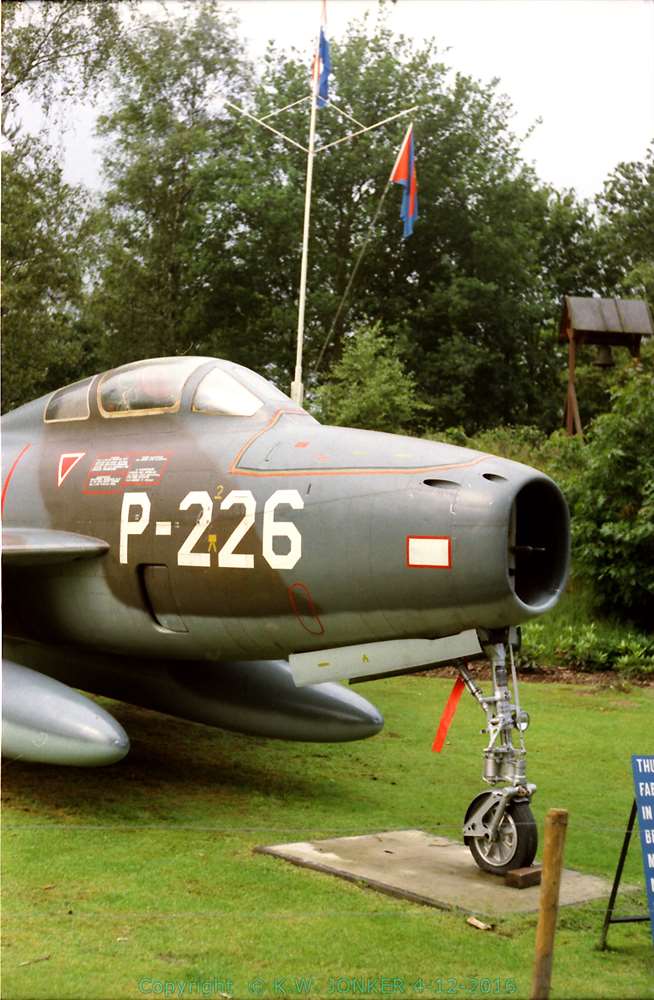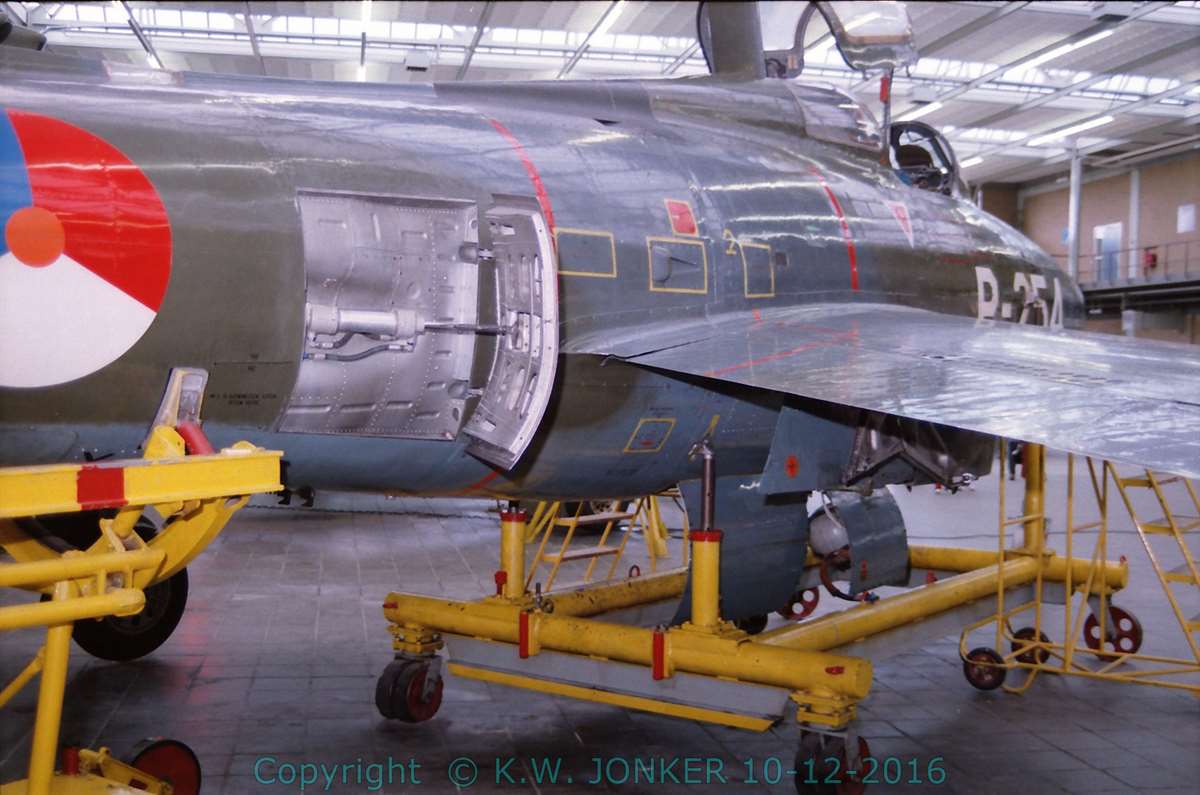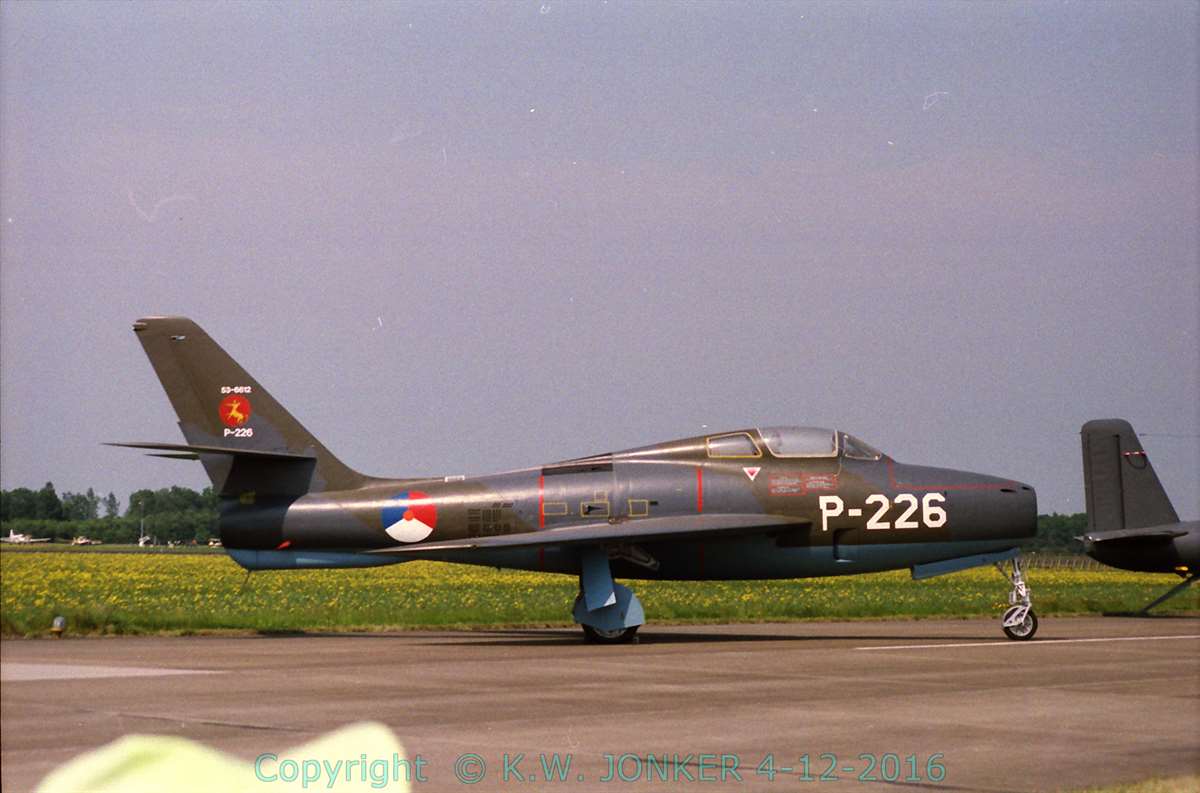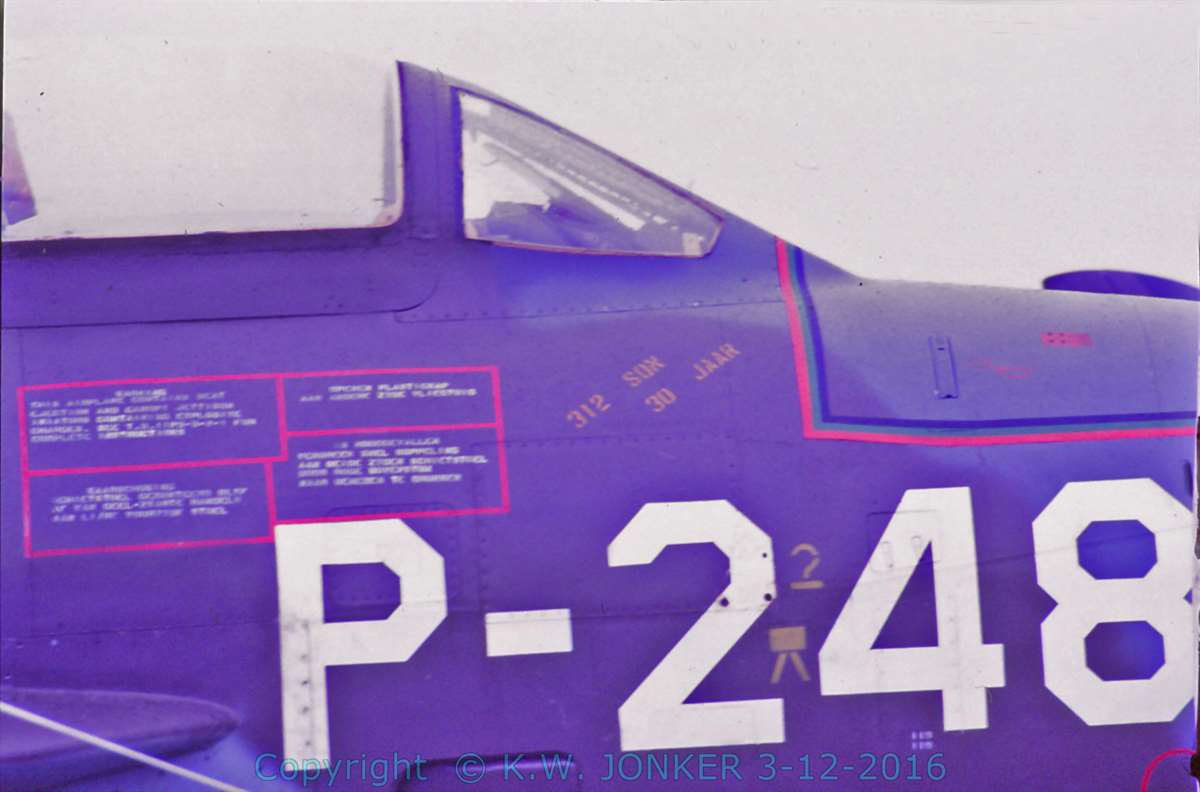The Netherlands received 180 Thunderstreaks under MDAP (= Mutual Defence Assistance Program) conditions. November 9, 1955 the first Thunderstreaks were officially handed over to the Minister of Defence. Most of the aircraft were delivered by ship and offloaded in the Merwehaven at Rotterdam.
A nightly transport by road to Avio-Diepen at air base Ypenburg followed.
Soon some problems with the wheels occurred, parts of the rim got loose. Because of the cold war, one thought of sabotage. Though the same problem occurred at Thunderstreak in the US, certain weather and production conditions caused this problem. Also several Thunderstreaks were transported through the air via the so called "High Flight"route via Copenhagen to the Netherlands.
No 311 squadron was the first to be operational with the Thunderstreak. The first Aircraft, registered P-103, was delivered November 29, 1955; the last and 25th Thunderstreak, registered P-239, was delivered June 20, 1956.
March 1956 the first Thunderstreaks were delivered to 312 and 313 squadron. 312 squadron received the last Thunderstreak, registered P-235, June 12, 1956.
March 9, 1955 313 squadron received the first Thunderstreak, P-214. because of delay of the delivery of the rest of the aircraft, eight examples were loaned from 312 squadron, so the Thunderjet could be withdrawn from use. At the end of 1956 the last Streak for 313 squadron were delivered, so its strength was 25 aircraft.
314 squadron received its first Thunderstreak, registered P-212,/8T-25 on may 1, 1956; its last example, P-161, was delivered just three months later. 314 squadron was part of the so called Allied Command Europe Mobile Forces (ACEMF) and was on a regular basis detached in Denmark and Norway.
April 28, 1956 the first Streak , P-205 for 315 squadron arrived. In September the squadron received its 27th and last Thunderstreak van. In the meantime two Streaks were written off due to accidents. May 1970 315 squadron was moved to air base Twenthe for the conversion to the NF-5. The remaining Thunderstreaks were handed over to 314 squadron.
July 27, 1956 the first three Streaks, P-157, P-166 and P-186 were delivered to 316 squadron; the last one was delivered in 1957. January 1958 the squadron was abolished, because due to accidents twenty-two Thunderstreaks had been written of and over thirty aircraft were in maintenance. The aircraft of the squadron were handed over to the other squadrons.
June 1958, 313 squadron was merged with the Jacht Vlieg School. Its Thunderstreaks were handed over to the other four CTL squadrons (Commando Tactische Luchtstrijdkrachten = Tactical Command).
Squadrons 311 and 312 squadron converted to the Lockheed F-104G Starfighter in 1964 - 1965. 115 Thunderstreaks were left for two squadrons. These Streaks were of different modification standards, so it was decided to withdraw the Thunderstreak F-48F-60-RE and earlier. On demand of the US twenty of these aircraft were handed over to Turkey. In 1970 both squadrons exchanged their Thunderstreaks for the Northrop NF-5.

Republic F-84F Thunderstreak P-226, photographed in 1985 at the Military Aviation Museum at Soesterberg.

Republic F94F Thunderstreak P-254, photographed in 1994 at the Anthonie Fokkerschool at The Hague.

Republic F-84F Thunderstreak P-226, photographed in 1995 at the Open Day Dutch Air Force at air base Volkel.

Republic F-84F Thunderstreak P-248, photographed in 1987
The Thunderstreak was rather difficult to fly and take off was rather sluggish. The Streaks nick name in the USAF was "ground loving whore”. Advantage was it massive construction. When the weather was warm four JATO rockets (Jet Assisted Take Off) were used. These rockets added an extra thrust of over 1880 kg for about 17 seconds. This JATO was rather expensive and used little in the Netherlands.
Despite it poor flying capabilities the Thunderstreak was used by several display teams, such as the famous US team ‘Thunderbirds’.
Also in the Netherlands several display teams used the Thunderstreak, such as the "Dash Four"team of 1956 and the “Red Noses-team.
In 1963 there was a team of 315 squadron “Sandbag Diamond” with four Thunderstreaks plus one solo. Very little is known about this team.
A well known team, which never flew an official display was the “Whiskey Four 67" of squadron 314. Seven aircraft had the special scheme applied. Because of an accident killing the pilot during a training flight the team was dismissed shortly before its first official display. In (the Dutch modelling magazine) ‘Modelbouw in Plastic, number 2, jaargang 17, 1988 a short article is published with photos and a drawn colour scheme.
In 1970 314 squadron raised a team, called "The Rascals" which displayed several times. In 1971 the team flew with the successor of the Thunderstreak, the Northrop NF-5.
The last operational flight with a Dutch F-84F was December 21, 1970.
Because of accidents 75 aircraft were written off during the fourteen years the Streak had been used. This is almost 42 % of the total amount of Thunderstreaks used in Dutch service.
Several Thunderstreaks are preserved in the Netherlands.
Status 1991 (source: Dutch Wrecks and Relics by W. Zwakhals):
- The Fokker factory school: P-172 and P-230 [I wonder what happened with these aircraft after Fokker's bankruptcy??]
- The Anthony Fokker school, The Hague: P-134 and P-254 (I photographed them in 1992; the aircraft were in excellent condition at that time.
- TU- Delft: parts of P-227
- Militaire Luchtvaart Museum at Soesterberg: P-226
- Air base Woensdrecht: P-170 airframe
- Air base GilzeRijen: P-191 as gate guard; and at DVM P-248
- Autotron at Rosmalen: P-263 [Nowadays Autotron is closed]
- At modelingDelta Mini Airport at Oss P-276
- At the MSS (Mineurs en Sapeur School) at Reek: P-224 and P-312 (in fact P-229)
- Air base Eindhoven: P-231 as gate guard and P-277 stored.
- Air base Deelen: P-243 as gate guard.
- LETS/Deelen: P-149 had been used as decoy at air base Soesterberg. It might be P-152, but this is uncertain.
- Air base Twenthe: P-166; P-171 and P-209. Air base is closed since 2004
- Air base Leeuwarden: P-194; In 1991 several parts were in use for fire practices.
 Nederlands (nl-NL)
Nederlands (nl-NL)  English (United Kingdom)
English (United Kingdom)